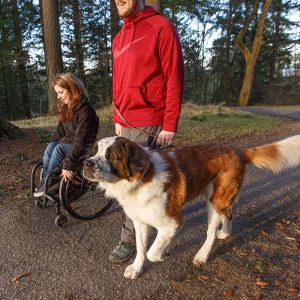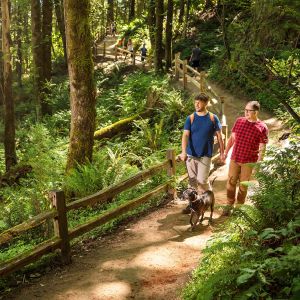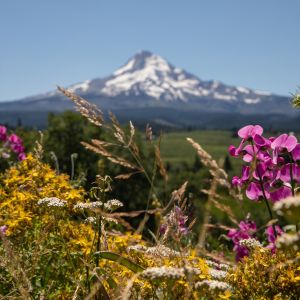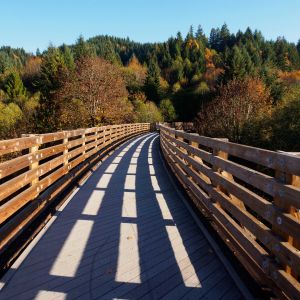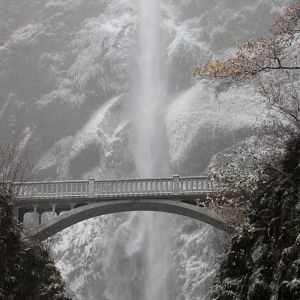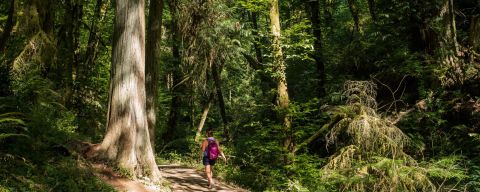

Soft Hiking in Portland
A collection of accessible soft hikes perfect for leisurely strolls or rolls and lots of meandering dilly-dallying. Finally, a hiking trend we can get behind…way behind.
Marina Martinez-Bateman
Marina Martinez-Bateman (they/them) is an equity and communications consultant and ghost tour guide who moved to Portland in 2014. Read More
Most visitors come to the Pacific Northwest for the incredible outdoor opportunities. Hiking in Portland is a top-tier way to spend a day, but if you’re easily distracted by a bumblebee butt sticking out of a flower, or you stop every few feet to contemplate a leaf, or you’re not a fast hiker, then this article is for you.
What is Soft Hiking?
Many of us slowpokes can be heard loudly complaining about fast hikers; the ones who treat Mother Nature’s sensory bounty like any old treadmill or stair-climber; the ones who time their ascent and are covered in the dust from their rapidly kicking feet; the ones who sincerely believe that every flowering moss patch and eddying stream is best viewed from above.

With a soft hike, a person or a small group gives themselves room to stop, lounge and take pictures or ponder nature while on the trails. I also ensured that at least some part of each trail listed below is accessible to hikers using mobility devices. Finally, I chose spots that were easy to get to because I don’t like being on remote or hard-to-find trails myself!
Powell Butte Nature Park
Powell Butte is the site of an extinct cinder cone volcanic vent and offers 9 miles (15 km) of trails and a cool, temperate microclimate, thanks to the surrounding meadows and forests. Powell Butte does have large areas of mostly uphill trails. However, most of the elevation is covered in the drive up to the parking lot, which means great views of Mount Hood that begin the moment you park.
Accessibility
Mountain View Trail, which is paved and wheelchair accessible, starts behind the visitor’s center and has an elevation change of about 170 feet (51 m). The trail goes up the butte’s summit and is just shy of 1.5 mile (2.4 km) long. Visitors report that their power chairs and mobility scooters can easily reach the top, while those of us using muscle power may experience light fatigue, depending on our regular habits. To combat fatigue and uphold the spirit of soft hiking, make plenty of stops for water, selfies and a tree hug or two. Dogs are allowed on leash and as long as they stay on the trails.
Glendoveer Golf Course
This 231-acre (93.5 ha) public golf course is bordered by a partially forested, 2.2-mile (3.5 km) trail that hikers, joggers and soft hikers are welcomed and encouraged to use. It’s also a stop on the 77 and the 25 bus lines. I recommend taking the north, west and east sides over the south path, which runs directly along busy Glisan Street and isn’t very covered. In the forested area, a person can still see and hear the street, but mature trees tower over you, and birds flit from branch to branch. The path is mostly bark chips and generally about three people wide.
Accessibility
While it’s not the most wheelchair accessible spot on this list, for those of us who struggle with elevation or uneven ground, the walking path is well-maintained, even and has no noticeable elevation. There is a minuscule paved section of the parking lot; however, the curb from the lot to the paved area might be too high for some mobility chairs. Dogs are not allowed because the trail is a designated wildlife area.
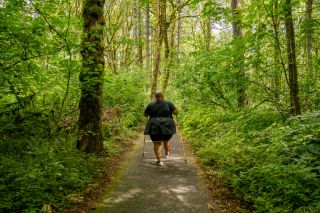
Credit: Justin Katigbak for Disabled and Here https://affecttheverb.com/disabledandhere/
Tualatin Hills Nature Park
Because this is a wildlife preserve with 222 acres (89.8 ha) of well-maintained habitat, the nature here is top-notch and my favorite on this list. There’s no shortage of fantastic photo spots like the turns near Big Pond on the Big Fir Trail and Lily Pond off the Vine Maple Trail. Here, you can spot native wildlife like birds, bugs, deer and even newts. There are ample opportunities to commune and de-stress in this beautiful park. It’s also situated away from major highways and roads, so you feel far away from the hustle and bustle of city life when you’re there.
Accessibility
You can take the MAX light rail to this park, and the Oak Trail (one of three paved options) starts in the parking lot next to the Blue Line stop. Altogether, there are 1.5 miles (2.4 km) of paved trails with another 3.5 miles (5.6 km) of relatively flat, well-maintained unpaved paths elsewhere in the park. Some of the unpaved trails are boardwalks, some are tamped gravel, and some are dirt. The hills are brief and easily avoidable. The area has benches and turnouts, and many parts of the trail are wide enough for three or four people to walk next to one another.
Sadly, dogs are not allowed, and while it is a bummer to have to leave furry friends at home, nature preserves like Tualatin Hills ask people not to bring dogs because the smell and sight of them would stress the wildlife into changing their habits, potentially causing them to leave the area permanently.
Cully Park
Formerly a landfill, this site was developed over a decade and won an Oregon Brownfields redevelopment award in 2018. A Brownfield site is any area that would be difficult to build on due to potentially hazardous materials, which are neutralized before the site is used again. Because this is a newer area, it lacks mature trees. However, that means nothing is getting in the way of the Mount Hood and Mount St. Helens views, and because of its proximity to the Columbia River, you can feel a pleasant breeze off the water on hot days.
Accessibility
Cully Park is the most accessible park on this list. The paved paths leading to every corner of this park are wide and can easily accommodate four or five adults walking side by side. Elevated areas can be accessed via a smooth paved path leading to a raised rock garden planted with native grasses and flowers. There’s also an accessible play area with transfer
stations where children who use mobility devices can transfer their device to different parts of the play area, sensory play areas, and a covered area with benches with wheelchair seating. Dogs are welcome as long as they are kept on leash.
Nadaka Park
A birders’ paradise and a great spot for kids, this small park comes in at about 10 acres (4 ha) in total but packs a lot of different experiences into one tiny space. There’s a lawn, a meadow, well-maintained community gardens, art installations and an impressive stand of mature trees to walk through on the north side. Several bird species like the spotted towhee, American robin, and Steller’s jay frequent the park. There’s also a large illustrated sign in English, Spanish and Russian naming the birds and describing some of their habits.
Accessibility
The front of the park is exceptionally well-paved, with large paths, open-air areas and a covered area with picnic tables next to a 58-plot community garden. There are several broad, flat fields and a wooden and multi-sensory play area for kids. The back of the park is about 8 acres (3.2 ha) and features a small walking loop with several branching trails that double back or lead into the neighborhood behind the park. The trail can comfortably accommodate four to five people across in most places, and there are several benches to sit and admire the view. While the path is packed evenly with dirt and gravel, it’s not paved. Dogs are allowed on leash.
Mentioned Elsewhere Online
Oregon Live
Access Recreation
Walks, Hikes and Sights
Explore the outdoors around Portland at your own pace.
Was this page helpful?

